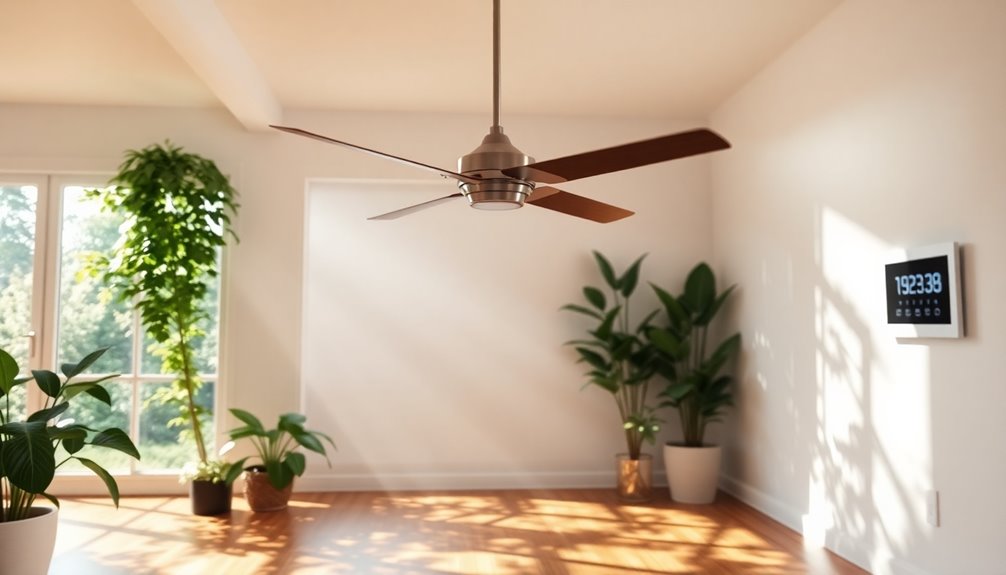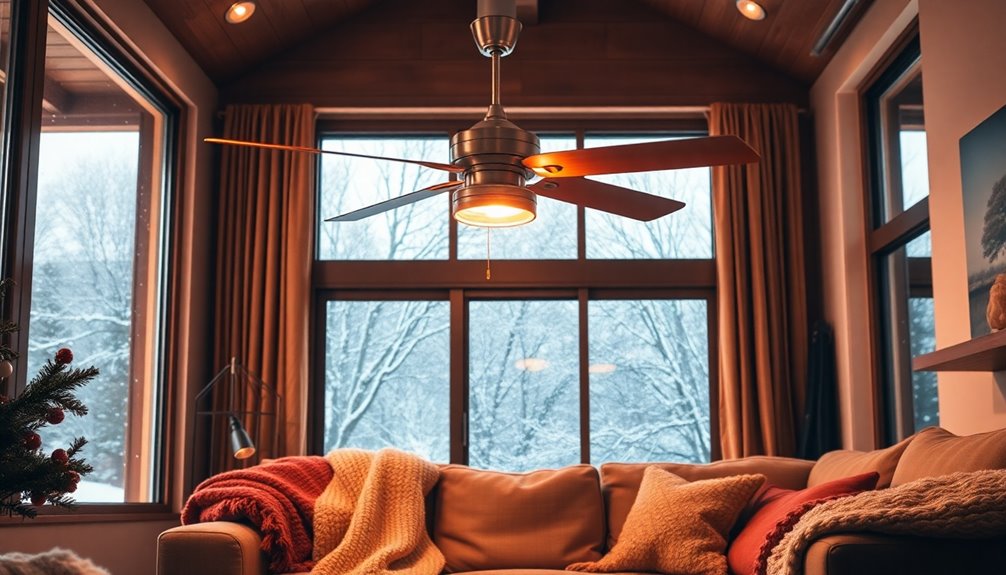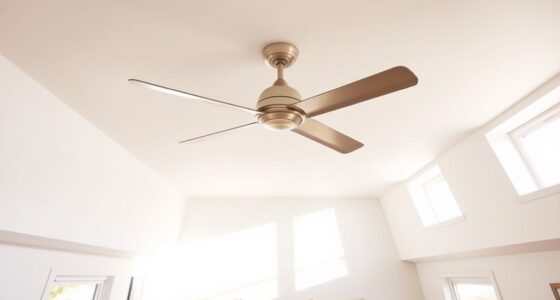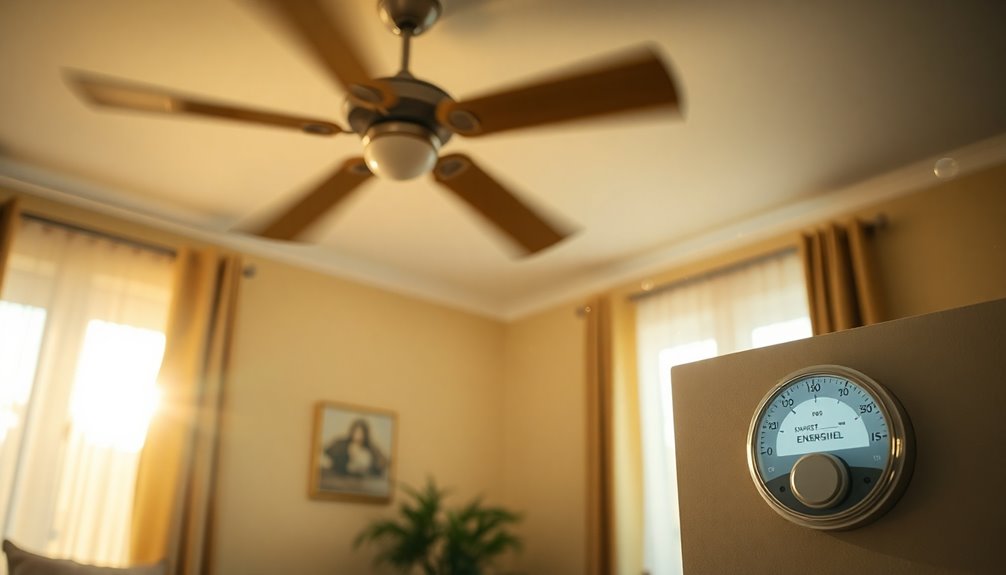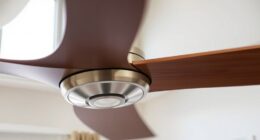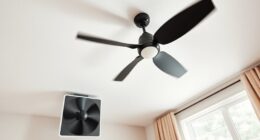Yes, using a ceiling fan can save you electricity. They consume much less energy than air conditioning units, averaging only one cent per hour. By raising your thermostat by 4°F while running a fan, you can cut cooling costs by about 12%. Ceiling fans enhance comfort through air circulation, making you feel cooler without lowering the room temperature. When used with air conditioning, you can even reduce energy consumption by up to 30%. Just remember to turn off the fan when you leave the room to maximize savings. There's more to explore about how to optimize your energy use effectively.
Key Takeaways
- Ceiling fans use only 30 to 50 watts per hour, significantly less than air conditioning units, which average $0.36 per hour.
- Operating ceiling fans allows for higher thermostat settings, reducing cooling costs by approximately 12% when set 4°F higher.
- Ceiling fans can lower overall energy bills by up to 20% during warm months by enhancing air circulation.
- Combining ceiling fans with air conditioning can achieve energy savings of up to 30%, reducing the workload on cooling systems.
- Effective fan usage minimizes unnecessary energy consumption and promotes comfort without additional cooling costs.
How Ceiling Fans Work

Ceiling fans are designed to cool you down by creating a wind-chill effect, which makes you feel more comfortable without actually lowering the room temperature. They work primarily by enhancing air circulation, promoting moisture evaporation from your skin. This process makes you feel cooler, even when the room temperature remains the same.
Using ceiling fans greatly reduces energy consumption compared to air conditioning units, which can draw a hefty amount of power. Ceiling fans typically use only 30 to 50 watts per hour, making them a much more energy-efficient option.
If you're using an ENERGY STAR® certified ceiling fan, you're likely benefiting from about 20% more efficient air movement than standard models.
Energy Savings From Ceiling Fans

Using ceiling fans can lead to significant energy savings, especially when paired with air conditioning systems. By raising your thermostat setting by just 4°F while using ceiling fans, you can enjoy cool air without cranking up your air conditioning. This simple adjustment can reduce your cooling costs by approximately 12%, allowing you to save money on your energy bills.
Operating ceiling fans typically costs around one cent per hour, compared to air conditioning units that average about $0.36 per hour. This means ceiling fans save energy and can dramatically lower your energy bills, potentially by up to 20% during warm months.
By better circulating the cool air, ceiling fans enhance comfort without requiring lower temperatures on your thermostat. For even greater energy savings, consider investing in energy-efficient ceiling fans certified by ENERGY STAR®. These fans can be up to 20% more efficient in air movement, further contributing to your savings. Additionally, selecting the best air flow ceiling fans can enhance cooling efficiency and increase comfort levels throughout your home.
Best Practices for Fan Usage

To maximize the benefits of ceiling fans and enhance your energy savings, it's important to adopt some best practices for their usage. Ceiling fans allow you to create a comfortable atmosphere while helping save on electricity costs.
First, remember to turn off your ceiling fan when leaving a room; running it in unoccupied spaces wastes energy. Adjust the fan speed based on room size and temperature—sometimes, a low setting might be all you need for better cooling in cooler conditions.
In summer, set your ceiling fan to rotate counterclockwise to create a cooling breeze. Conversely, switch it to clockwise in winter to distribute warm air evenly. You can also raise the temperature on your thermostat settings by about 4°F while using your ceiling fan, which can greatly save energy without sacrificing comfort.
Lastly, don't forget to regularly clean and maintain your ceiling fan. Dust buildup can impede airflow, increasing energy consumption.
Follow these fan tips to guarantee your ceiling fans operate efficiently and effectively, allowing you to enjoy a more comfortable living space while keeping your energy bills in check.
Ceiling Fans and Air Conditioning

When paired effectively, ceiling fans and air conditioning can create a more comfortable indoor environment while notably cutting energy costs.
By using ceiling fans, you can raise your thermostat settings by about 4°F without sacrificing comfort. This adjustment reduces the workload on your air conditioning system, leading to potential energy savings of up to 30%. Studies show that homes with security systems experience reduced risks of theft, which can also translate to lower insurance costs.
Operating a ceiling fan costs around one cent per hour, in stark contrast to the average running cost of an air conditioning unit at approximately $0.36 per hour.
The wind-chill effect generated by ceiling fans cools your skin, making higher temperatures feel more comfortable and decreasing the need for extensive air conditioning.
To maximize cooling efficiency, consider running your ceiling fans alongside your air conditioning system. Incorporating smart technologies can further enhance energy efficiency and comfort levels in your home.
With ceiling fans consuming only 30-50 watts of energy, they greatly enhance your cooling strategy while keeping energy consumption low.
By properly utilizing both cooling methods, you can achieve substantial energy savings and create a more pleasant indoor climate.
Embrace this combination for a smarter, more efficient way to beat the heat while saving money.
Installation and Maintenance Tips

Proper installation and maintenance of ceiling fans can greatly enhance their performance and energy efficiency. When you prioritize professional ceiling fan installation, you guarantee peak performance tailored to your home's needs. Remember to install the fan 8-9 feet above the floor to maximize airflow and improve cooling. Additionally, modern Energy Star certified fans can significantly contribute to lower energy bills by efficiently circulating air, similar to how best home security systems are designed for optimized performance. Regularly maintaining a clean and organized environment can also support emotional well-being, making your living space more enjoyable. Regular maintenance is key to prolonging your fan's lifespan, and it is advisable to regularly clean your fan to ensure optimal airflow. In addition, choosing a professionally installed system can provide you with added safety and efficiency benefits.
Regular maintenance is key to prolonging your fan's lifespan. Here's a handy table to guide you:
| Maintenance Task | Frequency | Benefits |
|---|---|---|
| Dust fan blades | Monthly | Improves airflow |
| Check for loose parts | Every 3 months | Enhances safety and efficiency |
| Inspect blade pitch | Annually | Guarantees energy-saving performance |
| Test pull chain | Seasonally | Maintains ease of use |
| Review installation | Every 6 months | Confirms adherence to safety protocols |
Focus on the blade pitch rather than the number of blades when selecting a fan to enhance energy-saving potential. Following these tips will keep your ceiling fan in top shape, guaranteeing you enjoy a cool, comfortable environment while saving on energy costs.
Economic Benefits of Ceiling Fans

Ceiling fans offer a practical way to cut down on energy costs while keeping your home comfortable. By using ceiling fans, you can save energy and reduce your reliance on air conditioners. When you raise your thermostat setting by just 4°F while running a ceiling fan, you considerably lighten the load on your air conditioner, which can lead to lower energy bills.
Operating at around 30-50 watts, ceiling fans consume far less energy than air conditioning units, which can cost you around $0.36 per hour. This difference not only helps you save on cooling costs but also provides an economic advantage that many homeowners appreciate.
In fact, about 75% of consumers report experiencing lower energy bills after incorporating ceiling fans into their cooling strategies.
If widely adopted, effective use of ceiling fans could contribute to billions in nationwide energy savings, benefiting both your wallet and the environment.
Strategies for Maximizing Efficiency

To get the most out of your ceiling fan, adjust your thermostat settings by 4-5°F higher while the fan is on.
Only run the fan when you're in the room, as leaving it on in empty spaces wastes energy.
Also, make sure your fan is rotating counterclockwise in the summer for ideal cooling.
Optimal Thermostat Settings
Maximize your energy savings by adjusting your thermostat settings in tandem with ceiling fan usage. By raising your thermostat by just 4°F while the fan is running, you can enjoy significant energy savings without sacrificing comfort. This adjustment allows you to set your thermostat about 5°F higher, which reduces the workload on your air conditioning system. Additionally, integrating this strategy with geothermal heat pumps can further enhance your energy efficiency.
The combination of a ceiling fan and higher thermostat settings can lead to energy savings of up to 20% during warmer months. Ceiling fans create a wind-chill effect, making warmer temperatures feel cooler, so you won't notice the difference in comfort. Additionally, understanding the refrigeration cycle can help you better appreciate how heat pumps work in conjunction with ceiling fans to enhance overall home comfort.
To optimize energy efficiency, regularly adjust your thermostat and guarantee that fans are running in occupied rooms. This way, you can maintain a pleasant air temperature while cutting down on electricity costs. Using ceiling fans in combination with heat pumps can significantly enhance thermal energy transfer throughout your home, leading to improved comfort levels.
Remember, using your ceiling fan effectively can help save energy, allowing you to enjoy a cool environment even as you raise your thermostat settings.
Proper Fan Usage
When it comes to proper fan usage, knowing how and when to use your ceiling fan can make a big difference in both comfort and energy efficiency. To maximize savings, remember that fans cool people, not spaces. As a result, turn off your ceiling fans when leaving a room. Running them in unoccupied areas wastes electricity.
During warm months, set your ceiling fans to spin counterclockwise. This creates a cooling wind-chill effect, helping you feel cooler without relying solely on air conditioning. In fact, you can increase the temperature on your thermostat by up to 4°F while still feeling comfortable, leading to significant energy savings.
Regularly cleaning and maintaining your fans guarantees peak airflow and efficiency, potentially lowering your energy bills by up to 20% during the warmer months.
Additionally, make sure you choose the appropriate fan size for your room. For example, a 44-inch fan is ideal for spaces up to 225 square feet.
Frequently Asked Questions
Do Ceiling Fans Help Lower Your Electric Bill?
Yes, ceiling fans can help lower your electric bill.
By using them alongside your air conditioning, you can raise your thermostat setting by about 4°F, which reduces the cooling workload.
Since ceiling fans only consume 30-50 watts, they use much less electricity compared to air conditioners.
This combination can lead to significant savings on energy costs, making it a smart choice for keeping your home comfortable while saving money.
Is It Cheaper to Run Ceiling Fans or Air?
When you compare the cost of running a ceiling fan to air conditioning, the difference is striking.
Ceiling fans, using just 30 to 50 watts, cost you about a cent an hour. In contrast, air conditioning can drain over 3,000 watts, racking up around $0.36 hourly.
Do Ceiling Fans Use a Lot of Electric?
Ceiling fans don't use a lot of electricity. Typically, they consume between 30 to 50 watts, which is much less than air conditioning units that can draw over 2,000 watts.
When you run a ceiling fan, it costs about one cent per hour, making it a cost-effective option for cooling your space.
How Much Does It Cost to Run a Ceiling Fan 24 Hours a Day?
You might think running a ceiling fan 24/7 would cost a fortune, but it's surprisingly affordable!
Depending on its wattage and your electricity rates, it'll set you back only about $0.24 to $0.72 a day. For a 50-watt fan, you're looking at roughly $0.60 daily.
That's a steal compared to air conditioning!
Just remember, turn it off when you leave—it cools you, not the room!
Conclusion
In the long run, using ceiling fans can definitely save you electricity and cut down on those energy bills. By understanding how they work and following best practices, you can maximize their efficiency. Pairing your fan with air conditioning optimizes comfort without breaking the bank. Just remember, a little maintenance goes a long way. So, keep your ceiling fan spinning and enjoy the breeze while keeping your wallet happy—it's a win-win situation!
